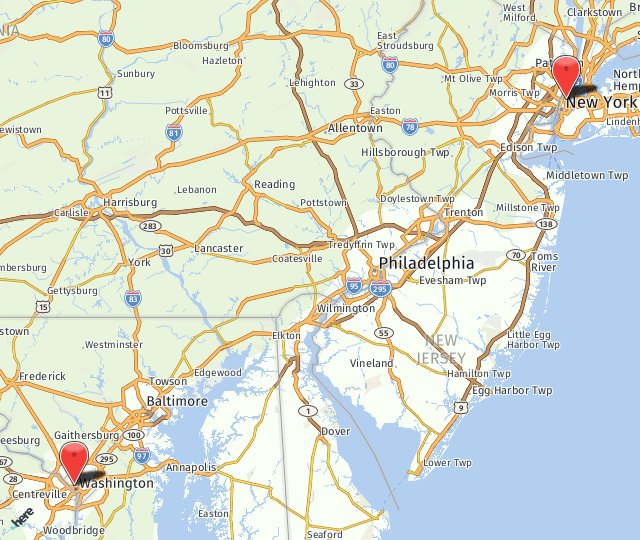A facelift, or rhytidectomy, is one of the most common facial plastic surgeries that Dr. Michael Somenek performs and can provide a remarkable improvement in your appearance. A facelift in Washington DC is recommended for patients who are concerned about saggy or loose skin and loss of facial muscle tone. As we age, skin tone and elasticity begin to decrease. When this is combined with changes in facial fat and loss of collagen, it translates to an aged face that lacks the characteristics of youth.
A facelift can correct these by removing excess skin from the face and neck and by sculpting the underlying tissues and muscles in your jaw, cheek, and neck area. In contrast to the traditional “skin tightening” that surgeons used to do years ago, newer and more sophisticated techniques have been developed to re-drape the skin so that it appears younger and smoother. Areas that are addressed by a facelift include:
- Jawline
- Prominent jowls
- Excess neck skin
- Submental fat and fullness
- Loose and sagging skin
Dr. Somenek’s Facelift Approach
As a facial plastic surgeon, Dr. Somenek applies the most advanced principles to create a refreshed appearance with longer-lasting results. Dr. Somenek’s philosophy is to create a natural look for the patient, avoiding an abnormal hairline or sideburns and the “pulled-back look” that some people develop postoperatively. He consistently discusses this concept with his patients during their consultations and explains that they will look and feel refreshed.
If you are unhappy with the lower two-thirds of your face including changes in your neck, Dr. Somenek may suggest you undergo a facelift in our Washington DC or New York City office. For patients with minimal skin laxity along the jawline, Dr. Somenek may suggest his Mini Facelift technique. Assessing the entire face is essential to maintain overall harmony and proportions which is why Dr. Somenek will frequently combine other procedures to strengthen your chin and improve your brow or eye area.
What is a Deep Plane Facelift?
This term refers to a particular approach to facelift surgery in which the area of focus is the layer of connective tissue under the skin but over the facial muscles. This deep plane facelift technique that Dr. Somenek regularly performs releases the ligaments that tether down the deep plane layer which allows for tension-free movement and no tightness to the overlying skin that can be seen by the standard facelift procedure.
Several ligaments get released during the deep plane facelift surgery. The zygomatic ligament is responsible for the drooping cheek. Releasing this ligament results in elevation and restoration of cheek shape and volume. This can also provide support to the lower eyelids by restoring some of the lost volume that has descended due to the effects of gravity.
Part of the deep plane facelift is address the muscle and skin laxity in the neck. During the procedure, Dr. Somenek also releases the cervical retaining ligament that tethers the platysmal muscle which is located in the neck. This allows for full release and repositioning of the platysma which frequently becomes lax and shows “platysmal banding” in the neck as one of the first signs of aging in this area of the face.
The other ligaments that are released all help to mobilize the deep plane layer and allow full and tension-free movement.
Is a Necklift Different from a Deep Plane Facelift?
Every patient’s anatomy and expectations are different depending on what age and what genetics they have leading up to their deep plane facelift.
Many times, part of the deep plane facelift is to address the muscle and skin laxity in the neck. This comprehensive approach combines the deep plane facelift procedure with additional procedures that specifically target the structures within the neck that are contributing to lack of definition to the jawline and submental region. This may involve reducing the size of the muscle and/or repositioning it. Patients frequently also have fat that is contributing to the fullness in this region which is also removed to further define the jawline region.
During the procedure, Dr. Somenek also releases the cervical retaining ligament that tethers the platysmal muscle which is located in the neck. This allows for full release and repositioning of the platysma which frequently becomes lax and shows “platysmal banding” in the neck as one of the first signs of aging in this area of the face.
Deep Plane Facelift Versus a Traditional SMAS Facelift?
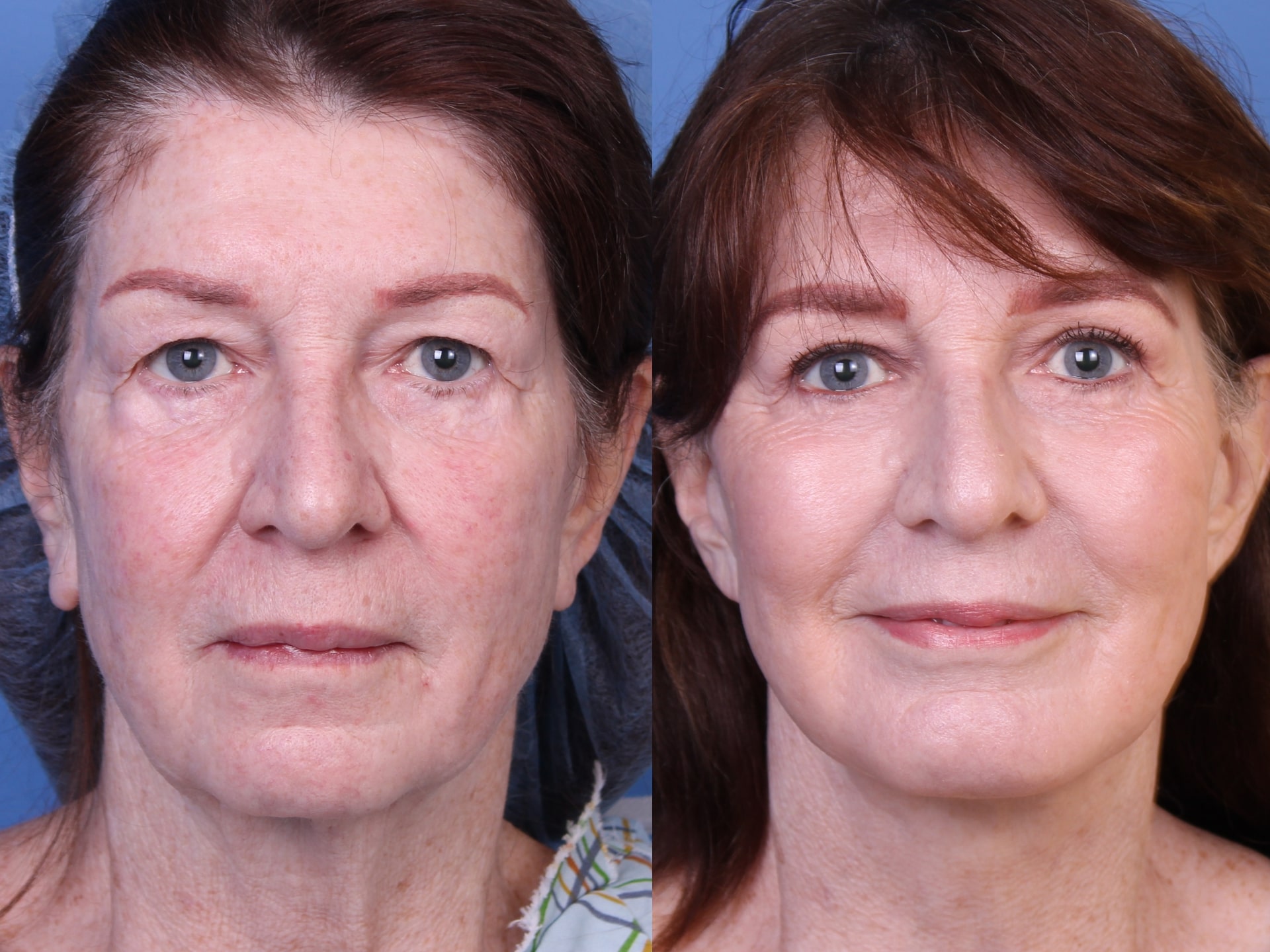
Patient underwent full facial rejuvenation which included a deep plane facelift, upper and lower blepharoplasty, and CO2 laser resurfacing. The deep plane facelift helps to restore the position of facial volume that has descended with age. A natural and refreshed look is the goal with this type of procedure.
The deep plane facelift focuses on some of the same concerns that are addressed in a traditional facelift. These include a softened or sagging jawline, flat cheeks, and creases between the nose and mouth (nasolabial folds). Using the traditional facelift method, a surgeon repositions the skin and and pulls the SMAS(Superficial Musculo-Aponeurotic System). This technique limits the amount of lift and repositioning that can occur and can predispose the patient to a tight look to the skin postoperatively. Additionally, the SMAS facelift does not adequately address the drooping cheeks because there is no release of the ligamentous attachments as is performed in the deep plane facelift method.
The SMAS facelift only separates the skin from the deeper muscles whereas the deep plane technique repositions the saggy muscles and fat compartments of the face and leaves the overlying skin intact. This tension-free closure provides a much more natural appearance long term.
Where are scars located for the deep plane facelift?
The incisions for the deep plane facelift heal extremely well with little to no visible scarring. The closure that is performed with this technique is a tension-free closure, without any pulling or distortion of the facial structures. The goal of the scars should be so that they are imperceptible to the eye once they are fully healed. Many of Dr. Somenek’s patients frequently comment how they are not even aware of the scars around their heals because they heal so well. Dr. Somenek also puts his patients on a specific scar therapy to optimize the appearance of the scars while they are healing.
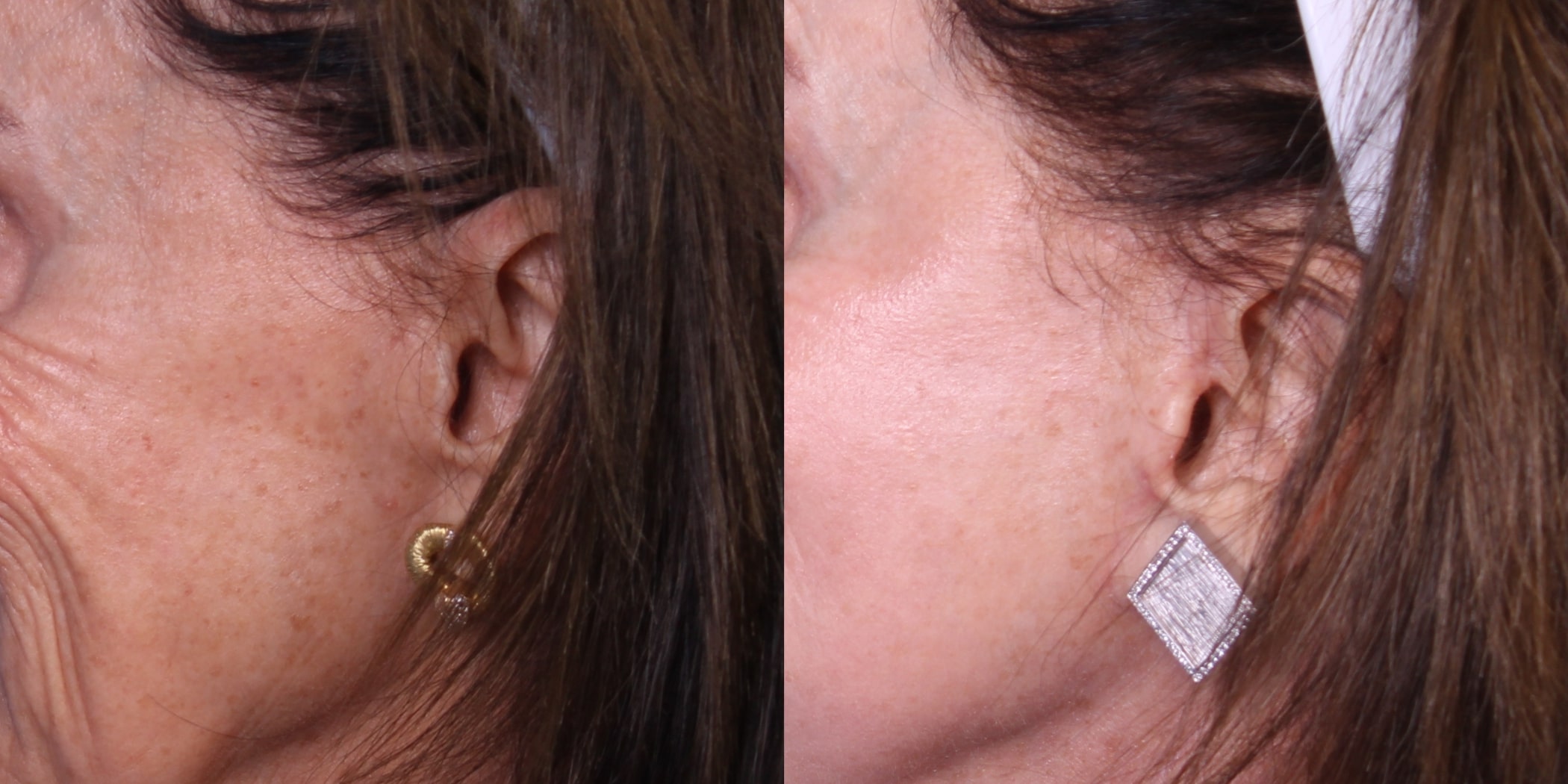
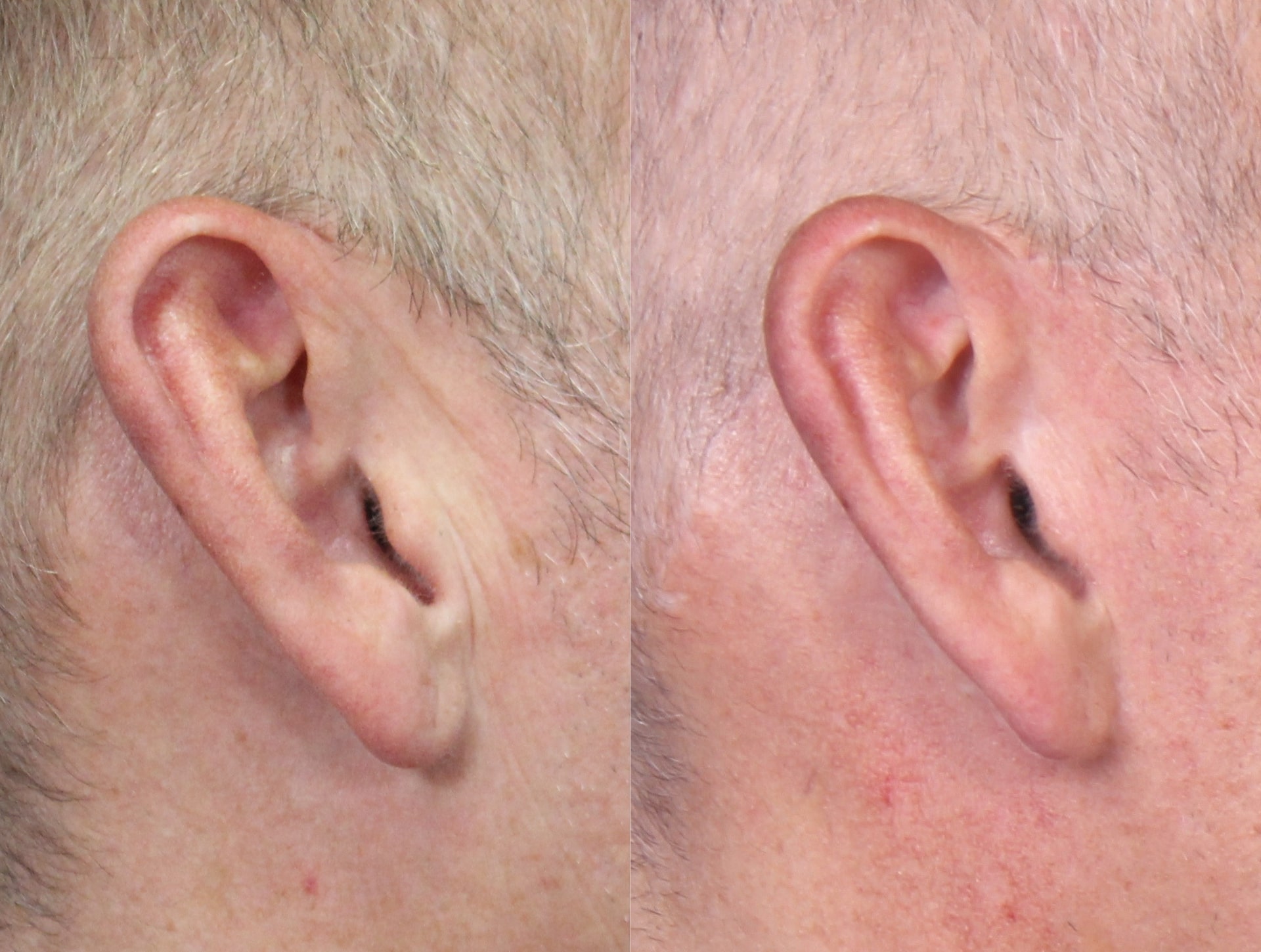
Example of a male and female who underwent a deep plane facelift, demonstrating how well their scars heal. Dr. Somenek strategically places the incisions in inconspicuous areas to minimize visibility. Around the ears, incisions are made within the natural creases to conceal the scar.
Your Facelift Consultation with Dr. Somenek
Before you schedule your surgery, you will have a thorough consultation with Dr. Somenek. He will assess all aspects of your facial features to determine the best manner in which to achieve a rejuvenated appearance and maintain harmony with the rest of your face.
As a leading expert in facial plastic surgery, Dr. Somenek believes that assessment of the elasticity and support of the underlying structures is a critical aspect of the consultation. This will help Dr. Somenek select the appropriate technique for your individual situation to provide you with beautiful and long-lasting results. He will discuss the necessary techniques with you to be sure that you understand each step of the process.
During your consultation, Dr. Somenek will provide a portfolio of before-and-after cases for your review. You will also have the opportunity to discuss other procedures that are commonly combined with a facelift, like eyelid surgery and fat grafting. Many patients decide to address multiple areas of their face when they get a facelift in Washington DC because each individual procedure comes with its own downtime.
Because of this, combining procedures minimizes the amount of downtime needed if you were to get each procedure done individually. In some patients, addressing multiple areas creates a more uniform and balanced appearance to the face.

How Long is Recovery After a Deep Plane Facelift?
It can take several months to completely heal after a deep plane facelift, but the majority of your recovery will take place in the first two weeks after your procedure. You’ll return home a few hours after your procedure, and we will see you in the office the next day, and at ~1- and 2 weeks post-op.
For your convenience, we also offer one-on-one nursing care that can accompany you to the hotel across the street from our surgical suite. Dr. Somenek will arrive at your room the next morning to see how you are doing and review the next week of recovery with you.
In the few days after your deep plane facelift, you can expect to develop some swelling and occasional bruising. You can help swelling resolve by following a low sodium diet and sitting more upright during the day and while you sleep. You may initially manage your post-op discomfort by taking prescription painkillers.
You can expect to look and feel significantly improved about two weeks after your facelift. The lower face and neck will still feel tight and a bit numb in some areas, which will resolve with time. You may still have some discomfort and minor bruising or swelling. These may be manageable with makeup and over-the-counter pain relievers. You may feel well enough to go back to work, provided that your occupation is not strenuous in any way. You’ll need to continue avoiding more rigorous physical activity for several weeks and we will give you specific guidance on returning back to your normal daily activities.
Most patients may travel 2-3 weeks after their procedure.
Our on-site Medical Spa offers recovery support, including lymphatic drainage massage (MLD), and hyperbaric oxygen therapy (HBOT), which may expedite your healing. To optimize your beautiful result, we will request that you continue to follow up with Drs. Somenek throughout the year following your procedure.
How Long Do the Results of a Facelift Last?
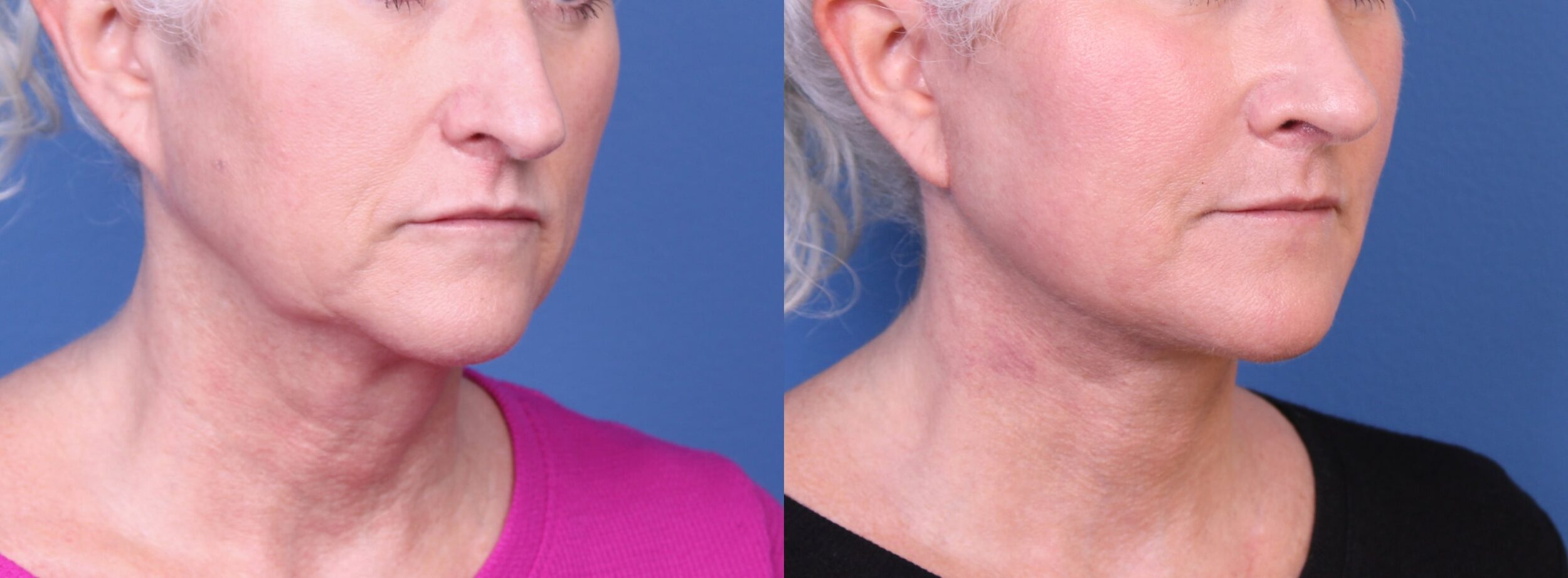
Patient complained of lack of definition to her jawline and overall heaviness to the mouth region. A deep plane facelift was performed which markedly improved the contour to the jawline and smoothed out the laxity in the neck.
A facelift does not stop the aging process. However, the appearance of the face will still be far better than if they had done nothing at all, and the patient will be starting from a new and improved baseline.
Other factors can also affect how long your results last, including weight fluctuations, your age when you underwent surgery, and your overall health and lifestyle choices. Factors like smoking and sun exposure are known for accelerating the facial aging process and will consequently shorten the longevity of your rhytidectomy results.
The aging process is also accelerated as we grow older. Therefore, younger patients who have facial procedures will most likely experience longer-lasting benefits. A healthier lifestyle can help to preserve your results.
Contact Our Office About a Washington DC Facelift Procedure Today!
To learn more about the deep plane facelift and how it can help you look 10 to 15 years younger, contact our Washington, DC office at (202) 933-5934.

